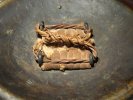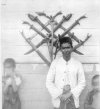I had no idea this was for the sword hand. The smaller size makes sense
no, it's held in the left hand if you are right handed. the 'on guard' position keeps the buckler near the sword hand to enable you to protect it and your left side. (see post below)the sword and buckler move independently. earlier 'on guards' with a simple cross hilt and no buckler tended to favour keeping the sword hand back or high. remember liam neeson in kingdom of heaven near the beginning, and balial in the initial encounter with the arab horsemnan.- a high guard. (also see post below)fairly accurately portrayed. the modern fencing one hand forward, the other behind is only practical with the cup guards on foils and epees. or a buckler. the sword slowly evolved, first a ring on the crossguard so you could loop a finger over it w/o fear of it being cut off. then a ring both sides, soon a quillion was elongated and bent down 90 degrees to protect the hand, the basket hilts/morutuary hilts/schiavonas soon followed. the buckler was redundant, frequently replaced with a left hand dagger. the ultimate was the rapier.

(my rapier)
as they evolved, they found that they didm not need quite so much protection when evryybody was carryin these, so the number of rings reduced until we had the small sword with a pure thrusting blade that only needed a small shell guard either side and a basic hand guard and quillion.

this was the last sword commonly carried by civilians, such practice died out ealy in the 19th c., being replaced with pistols and knives.
military useage lasted longer but tended to maintain a more protective guard for infantry and cavalry, while naval swords came to look like this:

d-guard, quillion, rudimentary asymmetrical shell mostly on the right side to protect the back of the hand, the left is cut back to cut down on it poking your side when carrying it.
(mine has a black real rayskin grip. the PX/exchange 'issue ones' are white plastic imitation rayskin, and have cheap fragile untempered stainless blades. mine is 1065 HC steel (and sharpened too)
p.s. - navy milspecs do not mention the color of the grips

, it is basically a thrusting blade.
the vavy still use a cutlass with a bowl guard based on an 1860's design, the later milsco model used in ww2 was not chosen. guess it was too tactical'

note he also carries a longer springfield sword bayonet for his M1, the issue one was a lot shorter.

(mine -actually a dutch klewang cutlass that the milsco one copied failthfully)














, Lander?
